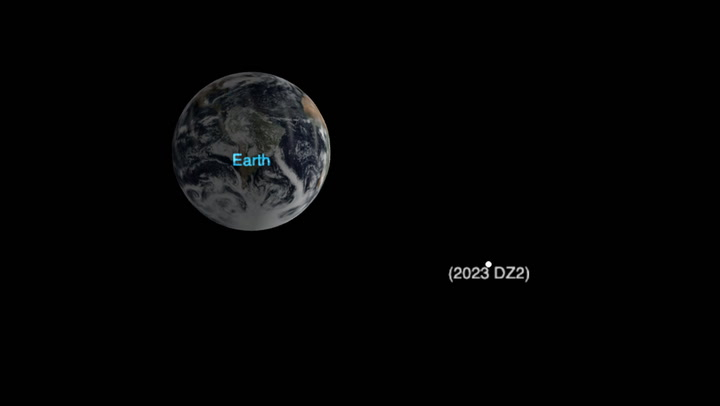23.03.2023
Asteroid 2023 DZ2 will zip between Earth and the moon's orbit on March 25 and may be visible with the right telescope.

The newfound asteroid 2023 DZ2 is seen during its close approach to Earth on March 25, 2023 in a NASA animation. (Image credit: NASA/JPL-Caltech
An asteroid three times the size of the one that blew out windows in Chelyabinsk, Russia in 2013 will zip by Earth at half the distance of the moon on Saturday (March 25).
Fortunately, the asteroid, known as 2023 DZ2, will make a clean pass by our planet, speeding by at 17,426 mph (28,044 km/h), according to EarthSky(opens in new tab). Skywatchers with 6-inch (15 centimeters) telescopes or larger have an opportunity to see the space rock on Friday evening (March 24) from the Northern Hemisphere. The Virtual Telescope Project(opens in new tab) will also show a livestream of the asteroid at 7:30 p.m. EDT on Saturday (23:30 UTC).
Observed through a telescope from the Northern Hemisphere, the asteroid will look like a slow-moving star over the southeastern horizon, east of the constellations of Orion, Canis Major and Canis Minor, according to EarthSky. Its closest approach will be at 3:52 EDT (19:52 UTC) on March 25.
The asteroid was first discovered by astronomers at the La Palma Observatory(opens in new tab) in the Canary Islands in February 2023, according to EarthSky, and is estimated to be between 144 and 325 feet (44 and 99 meters) in diameter. Because it crosses Earth's orbit, the asteroid is known as an Apollo-class asteroid. Though the precise origin of 2023 DZ2 is unknown, most near-Earth asteroids are natives of the asteroid belt between Mars and Jupiter that were kicked out of their typical orbits by interactions with Jupiter, according to the Encyclopedia of Physical Science and Technology(opens in new tab) (2003).
If 2023 DZ2 were to smash into Earth, it would potentially cause major damage. The Chelyabinsk meteor that exploded over Russia in 2013 was likely about 59 feet (18 m) long and damaged 7,000 buildings, injuring more than 1,400 people (mostly due to flying glass). The new visitor is estimated to be at least three times larger.
Fortunately, the asteroid will remain about 107,500 miles (173,000 kilometers) from Earth, according to the Virtual Telescope Project. Given what is known about 2023 DZ2's orbit right now, there is a 1-in-430 chance that it will impact Earth on March 27, 2026. However, according to EarthSky, that slight chance is likely to vanish as astronomers learn more about the asteroid's trajectory. The space rock orbits the sun every 3.17 years.
While 2023 DZ2 does not currently present a threat to Earth, the NASA Center for Near Earth Studies Sentry program is currently monitoring 24 known objects(opens in new tab)with small chances of hitting Earth in the next century.
Quelle: SC
